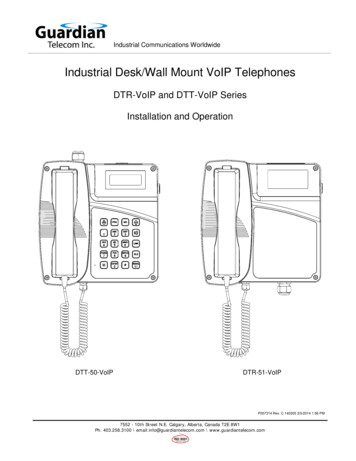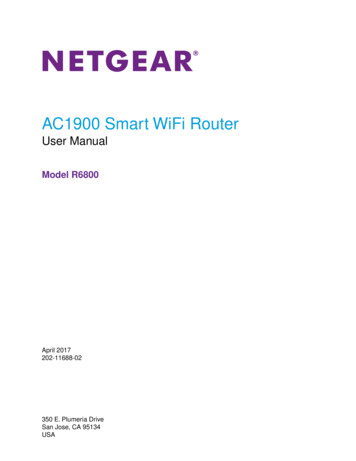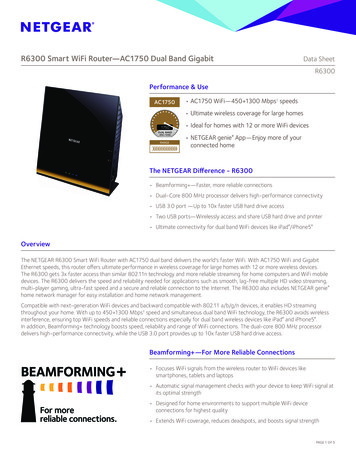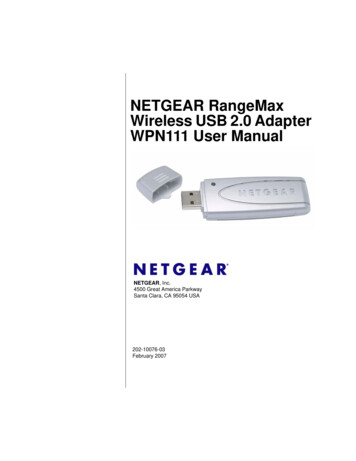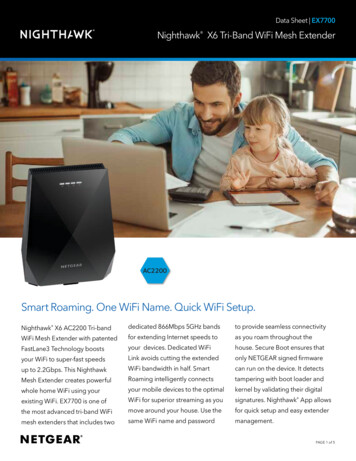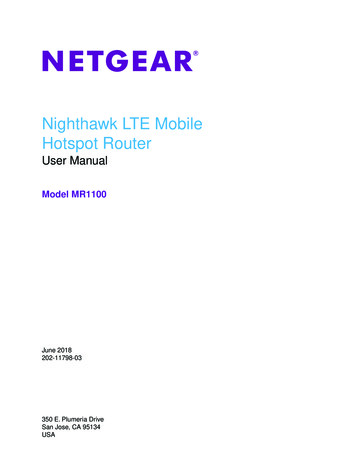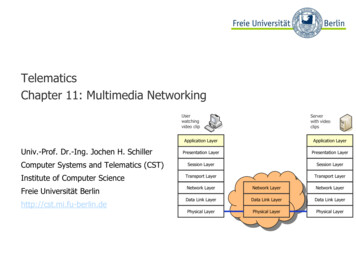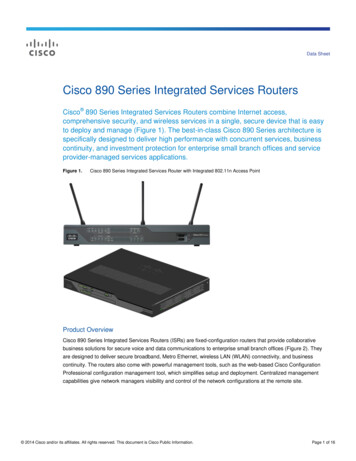
Transcription
Networking Solutionsfor VoIP
Table of ContentsQoS: The Prime Mover.3Benefits of VoIP.3VoIP Network Components and Protocols.4CODECs.5Signaling Protocols.5The LLDP-MED Protocol.5Security.5Network Planning – General Considerations.6Choosing a Switch: Bandwidth & Ports.6Choosing a Switch: Power over Ethernet.7Reference Designs.820 Phones.8200 IP Phones.101000 IP Phones.12Managed Infrastructure.16Page 2
VoIP has become a mainstream technology. Today, the question for business telephony at any scale is no longer whetherto switch to VoIP, but when. This paper focuses on the internal networking aspects of making a successful transition toVoIP, with emphasis on network design and switching technology.QoS: The Prime MoverThe most important factor that has moved VoIP into the mainstream is improved quality of service (QoS)1. Businessesthat have held back because of VoIP’s early reputation for poor voice quality need no longer be concerned that importanttransactions (such as sales) will be impeded by poor QoS, or that their company will make a less than fully professionalimpression on callers with VoIP.Today, excellent quality of service can always be achieved with VoIP, but it’s not guaranteed. QoS ultimately depends onthe switches that control the VoIP traffic, and of course, the network over which that traffic travels. It’s understandablethat the focus of attention in a transition to VoIP is typically on the service provider, the delivery model (onsite vs. hosted)and the IP phones, but the switches have the most important impact on the user experience. With NETGEAR switches, VoIPtraffic can be automatically prioritized to maintain the desired QoS, even when the network is saturated.The key factors required to ensure a successful VoIP network with reliable QoS are as follows: Voice packet prioritization. The switch(es) that manage the traffic must be able to prioritize voice traffic whennecessary to maintain QoS. Adequate bandwidth. The network and the switch(es) that control it must be able to handle the additional loadimposed by a VoIP deployment. Resilience. The network switch(es) must have access to an alternate power supply should the main source ofpower fail. Security. The network must be protected from hacking, including physical hacking.The first factor – packet prioritization – deserves more explanation. VoIP streams are not forgiving when it comes todropped packets, signal delay and other factors that don’t affect data traffic. Therefore, to ensure a consistently highlevel of QoS, the switches must be able to prioritize network traffic, giving voice packets top priority. NETGEAR switchesaccomplish this automatically.Benefits of VoIPThis guide will help you understand the basics of VoIP so you can successfully plan and specify a VoIP network. It includesreference designs for VoIP networks with 20, 200 and 1,000 IP phones. Before covering design issues, however, it’s worthreviewing just why VoIP has become the solution of choice for organizations of all sizes.The term “Quality of Service” and its abbreviation, QoS, has long been used in the literal sense of voice quality, i.e. how closely what the user hears matchesthe original. Recently, however, the term has begun to be used to describe the voice packet prioritization technology that is used to ensure high QoS even duringperiods of network congestion. In this document, QoS refers only to the original meaning of the term.1Page 3
VoIP’s packet-switched solutions are winning the marketing battle over conventional circuit-switched telephony becausethey offer advantages that conventional POTS (“Plain Old Telephone Service”) just can’t match. These include: Price. VoIP is substantially less expensive than circuit-switched telephony. In fact, online services like Skype enableindividual users to international calls of unlimited duration for free. VoIP for business purposes isn’t free, but it isdramatically cheaper than today’s circuit-switched options. Quality of service (QoS). In the past, the reduced cost of VoIP came with a penalty: reduced QoS. Today’s VoIPtechnology can provide voice quality that equals or even exceeds what conventional circuit-switched systems offer. Complexity. Switching to VoIP typically reduces the complexity of dealing with “the phone company” and its arcanepricing structures, which even highly-paid consultants can’t always understand. Features. VoIP can now match conventional telephony feature-for-feature, ranging from basics like voice mail toemerging capabilities like presence sensing. Integration. More and more of today’s business applications, including CRM and call center applications, are groundedin internet-related technical standards. VoIP technology can be integrated with these applications much more easilythan the analog technology of conventional telephony. Ease of administration. Adding, removing or changing internal numbers is a simple process with VoIP’s web-basedinterfaces, and with auto discovery features, activating a new phone is virtually automatic. Deployment advantages. VoIP can be piggy-backed on an existing network infrastructure, including the physicalcabling. This means lower initial cost (with no new wiring) and lower maintenance cost as well. No risk of obsolescence. VoIP is the wave of the future. Companies who adopt VoIP have no risk of ending up with a“dinosaur” phone system that can’t operate efficiently in an all-digital world.VoIP Network Components and ProtocolsNo matter what the size of a VoIP network, it will always include one or more of the following components: User agents. These may be commercial IP phones, or “soft phones” residing in a desktop or laptop PC. Voice gateway. The gateway acts as the bridge between a VoIP network and the PSTN network of the “outside world.” IPBX. The IPBX (sometimes referred to as an IP PBX) replaces the conventional PBX of the past, and performs all itsfunctions (voice mail, call forwarding, conference calling and many, many more). It connects to the PSTN network viathe voice gateway. The IPBX is available in three deployment options:– a dedicated, on-site hardware device– software that runs on a standard on-site server– a managed service via the cloud Switches to manage network traffic. The switches are crucial, because if they lack the appropriate capabilities orbandwidth capacity, QoS will suffer, leading to user complaints, poor customer service and problems with externaltelephone communication in general. Cabling. For adequate performance, Cat5E or better cabling is recommended.Decisions involving these components can directly affect QoS, based on which protocols they support. For example,some IP phones use protocols that deliver higher voice quality, but also require more bandwidth. Before reviewingthose protocols, it’s worth taking a moment to examine QoS in a little more detail.QoS is ultimately a subjective measurement, because different individuals will invariably disagree as to how well a systemcan reproduce a voice that’s known to them. However, one decades-old attempt objectify QoS does exist. Developedinitially for evaluating circuit-switched equipment, it provides a measure of quality known as Mean Opinion Score (MOS)based on individuals sitting in quiet rooms and rating voice quality. MOS can range from 1.0 (unintelligible) to 5.0 (ideal).Normally a score above 4.0 is considered to be acceptable, but what’s most important is that QoS can be quantified, andcomponents/protocols can be evaluated based on the MOS score they promise as well as their bandwidth requirements.Page 4
There are numerous protocols that govern VoIP systems, but three are of primary concern for VoIP networks: protocols for the CODECs that govern analog/digital conversion and the signal compression that takes place in theVoIP gateway (inbound) and the user IP phones (outbound) signaling protocols that govern the voice packets and their transmission The LLDP-MED protocol extension, used by network devices such as IP phones for advertising their identity,capabilities, and neighborsCODECsPopular protocols include G.711, G.729, G.723.1 and G.722. There are others as well, some of which are proprietary.These protocols are important because they differ in their sensitivity to various frequency ranges (e.g. voice only vs. voiceand music), offer different levels of QoS, and impose different bandwidth requirements. It’s not necessary to understandtheir details, but it is important to know that they represent options. As would be expected, the higher the QoS, thegreater the bandwidth required. Many IP phones support multiple protocols, but that is not always the case.Signaling ProtocolsThe signaling protocols govern the set-up and tear down of calls, as well as many other related call management functions.There are three major signaling protocols: H.323. This is the “oldest” protocol – it is actually a set of protocols – and it is widely distributed. H.323 was designedfor multimedia communication services such as real-time audio, video, and data communications over packet networks,including IP networks. Based on binary encoding, is it considered somewhat harder to program than its “competitor,” SIP. SIP (Session Initiated Protocol). This slightly younger protocol accomplishes most of the functions available underH.323, but is somewhat lighter (i.e. requires less bandwidth). It is text-based. The industry consensus is that SIP willeventually come to dominate VoIP communication, with the caveat that multiple protocols are likely to exist into theforeseeable future. SCCP (Skinny Client Control Protocol). This is a proprietary CISCO signaling protocol used by CISCO IP phones andthe CISCO call manager. It is a stimulus-based protocol which achieves its “skinniness” by transferring functions to thecall manager.The LLDP-MED ProtocolLLDP-MED stands for Link Layer Discovery Protocol with Media Endpoint Discovery. When IP phones are LLDP-MEDenabled, NETGEAR switches can automatically configure them so that they “know” which VLAN to join and what theirQoS assignment is2. This protocol also enables automated power management of PoE-powered IP phones – virtuallyall IP phones are powered this way – as well as other convenience features such as device inventory management.SecurityA separate, but extremely important consideration that requires some explanation is network security in an IP network.Obviously, any network will be protected through access control, e.g. support for role-based access with authenticationand passwords. In addition, IP networks have a physical vulnerability. An attacker could easily disconnect a IP phone and puta PC in its place, thus obtaining unauthorized access to the network.To prevent this, NETGEAR switches make use of the unique Media Access Control or MAC address for each physical IPphone. NETGEAR switches can sense this address, and be programmed to block any unauthorized device. The ultimate inprotection can be achieved through the use of the Radius (Remote Authentication Dial-In User Service) protocol associatedwith an authentication server, or a Windows Server 2008 Network Policy Server (NPS) that can block access to ports evenif hackers succeed in spoofing and emulating MAC addresses during an attack.2The IP phones must tag their traffic using the correct VLAN tag, and mark their traffic using the correct Layer 2 802.1p or Layer 3 QoS values.Page 5
Network Planning – General ConsiderationsThe planning of a VoIP network has several steps, as show below:Fast Ethernetvs. GigabitBusinessRequirementsIP PhoneConfigurationSwitchingRequirementsNumber ofIP PhonesBusiness requirements – QoS, number of users, types of user devices and the like – will determine the number of IPphones and their configuration (e.g. presence or absence of a soft phone connection or use of mobile devices).The number of IP phones, combined with the need for a Fast Ethernet vs. Gigabit connection, will in turn determinebandwidth and power requirements for the switches. The following section will focus on the details of choosing theappropriate switch(es).Choosing a Switch: Bandwidth & PortsNETGEAR recommends two lines of managed switches for VoIP networks: The NETGEAR Intelligent Edge M4100 series. These are FastEthernet (10/100) and Gigabit Ethernet (GigE) access layerswitches with several Gigabit ports for uplink functions. The NETGEAR Next-Gen Edge M5300 series. Theseare Gigabit Ethernet (GigE) switches with embedded10 Gigabit ports (10GbE) for uplink functions andvirtual chassis stacking.Page 6
Determining which switch within these two families requires answering four questions.1. Will the IP phones require a Fast Ethernet port (at the switch) or a Gigabit Ethernet port? Most entry-level desktopIP phones have only one port, which is a Fast Ethernet port. In this case, cost-effective NETGEAR Fast Ethernetswitches may be adequate, based on the total bandwidth requirement. (See question 4.) Note that these FastEthernet switches, in spite of their name, do include a Gigabit port for uplink purposes in a two-tier network.Sometimes, however, even a deployment with only single port Fast Ethernet IP phones may require 10 Gigabituplink capabilities.Today’s high-end, state-of-the-art phones often have two ports, one that connects to the switch and another thatconnects to a co-located PC. If the co-located PCs on the network require Gigabit speed, then of course a Gigabitswitch is required.2. What is the average bandwidth required per IP phone? As explained above, VoIP bandwidth requirements dependon a number of factors, primarily the protocol/compression algorithm used by the codecs (the “G-number”) and, toa lesser extent, the signaling protocol (SIP, H.323 or SCCP). Calculating this figure can be quite complicated, and thebest way to determine it is simply to consult with the IP phone vendor. Best practice in calculating the bandwidthload on the network is to assume 100 percent usage by every IP phone. This will ensure that the network will be ableto handle peak usage periods.3 How many IP phones will be on the network? This determines how many ports the switch(es) will need – one portper IP phone. Note that all of the NETGEAR Fast Ethernet switches are equipped with several Gigabit ports foruplink purposes.4. What is the total bandwidth required per switch? This is a simple calculation:Average bandwidth per IP phone x total number of IP phones total bandwidth required (Gbps)The total Gbps that the switch can transfer – the “switching fabric” of that switch – must exceed the answerto this equation. And if the switch must be connected to an upper layer (such as a Core or Distribution Layer),then the uplink connection must support the total bandwidth required for that uplink without creating a bottleneck.Choosing a Switch: Power over EthernetVirtually all IP phones are designed to accept Power over Ethernet (PoE). There are two versions available, PoE and PoE .For IP phones, the 15.4W per port (12.9W to the IP phone) provided by PoE is adequate.To determine which switch in the M4100 or M5300 family is required for a particular installation from a PoE perspective,ask the following questions:1. How many watts are required per IP phone? This information can easily be obtained from the vendor.2. How many IP phones will be on the network?3. What is the total wattage requirement? It can be calculated as follows:Average watts per IP phone x total number of phones total PoE budget requiredObviously, the power capacity of the switch – its “PoE budget” – must exceed the total power requirements of theIP phones on the network.Page 7
Reference DesignsThe following reference designs will provide general guidance on how to plan a highly reliable and cost-effective VoIPnetwork. Each network was designed with four criteria in mind: simplicity, to enable easy installation and management voice packet prioritization, to ensure that a high level of QoS will always be available resilience, to ensure the 24/7 coverage that’s a requirement for a business-critical function like telephone service securityReference Design: 20 PhonesThe diagram below shows a typical installation with 20 IP phones. It is a complete solution compatible with all majorsignaling protocols, and is ideal for a small business or branch office that wants to enjoy the benefits of VoIP withmaximum simplicity. The IP phones and the IP PBX/voice gateway are all on the same subnet and same VLAN. Allthe traffic is managed by a single switch, and that switch automatically applies QoS policies to ensure high QoS atall times, even when the network is congested.“Rest of the Network”IP PBX, SIPServeror 9TM4100-50G-POE 50T47F48F49F50FFanCombo PortsRPSMaxPoEResetUSB113141516171819202122PoE (Max 30W per port): Of f no PD Green PoE Powered Yellow PoE f ault RJ45 SPD mode: Green Link at 1G Yellow Link at 10/100M Blink 647T48T49T50T47F48F49F50FSFP SPD/Link/ACT mode: Green Link at 1G Yellow Link at 100M Blink ACTCopper, Gigabit RJ45ClientsCopper, 10/100 RJ45Copper, 10/100 RJ45 PoEIP Phones (20)The benefits of this design include the following:Simplicity The switch can be configured with a unique, easy-to-use web-based interface as well as the industry-standardcommand line interface (CLI). The IP phones’ IP configuration (including every kind of VoIP DHCP option setting) is automatic via a DHCP server orthe NETGEAR switch, with no manual intervention required. QoS is handled automatically to maintain a constant high level. A separate cabling system for telephone service is no longer required, which vastly simplifies the process of adding orchanging phone service for employees. The IP phones can keep their default configuration for VLAN and QoS settings. The switch will
The gateway acts as the bridge between a voiP network and the PSTn network of the “outside world.” IPBX. The iPBX (sometimes referred to as an iP PBX) replaces the conventional PBX of the past, and performs all its functions (voice mail, call forwarding, conference calling and many, many more). it connects to the PSTn network via

